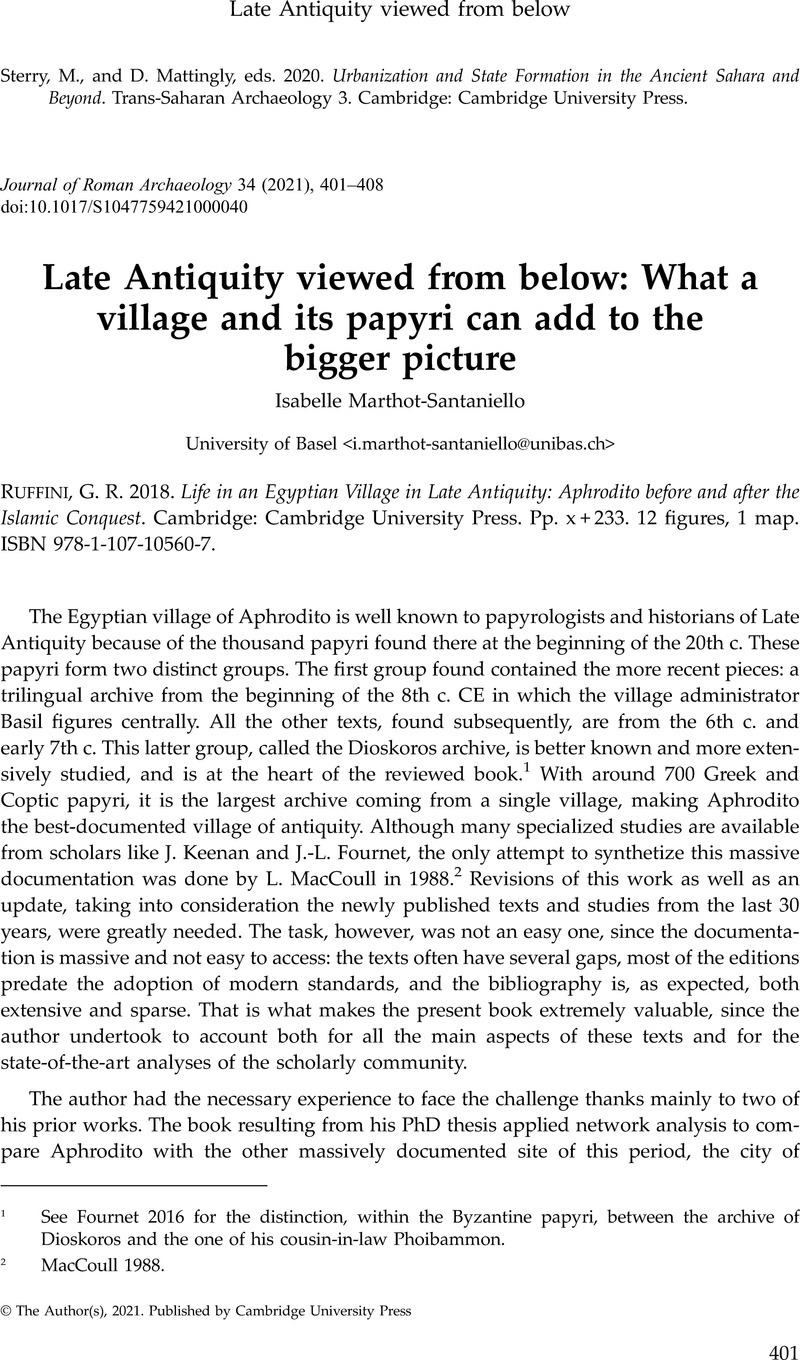No CrossRef data available.
Article contents
Late Antiquity viewed from below: What a village and its papyri can add to the bigger picture - G. R. Ruffini 2018. Life in an Egyptian Village in Late Antiquity: Aphrodito before and after the Islamic Conquest. Cambridge: Cambridge University Press. Pp. x + 233. 12 figures, 1 map. ISBN 978-1-107-10560-7.
Review products
G. R. Ruffini 2018. Life in an Egyptian Village in Late Antiquity: Aphrodito before and after the Islamic Conquest. Cambridge: Cambridge University Press. Pp. x + 233. 12 figures, 1 map. ISBN 978-1-107-10560-7.
Published online by Cambridge University Press: 05 April 2021
Abstract
An abstract is not available for this content so a preview has been provided. Please use the Get access link above for information on how to access this content.

- Type
- Book Review
- Information
- Copyright
- Copyright © The Author(s), 2021. Published by Cambridge University Press
References
Cadell, H. 1967. “Nouveaux fragments de la correspondance de Kurrah ben Sharik.” Recherches de papyrologie 4: 107–60.Google Scholar
Davis, N. Z. 1987. Fiction in the Archives: Pardon Tales and Their Tellers in Sixteenth-Century France. Stanford: Stanford University Press.Google Scholar
Fournet, J.-L. 2015. “At the desk of a man of letters: Literate practices in Byzantine Egypt according to the dossier of Dioscorus of Aphrodite.” In Languages and Cultures of Eastern Christianity: Greek, ed. Johnson, S. F., 221–48. Farnham: Ashgate.Google Scholar
Fournet, J.-L. 2016. “Sur les premiers documents juridiques coptes (2): les archives de Phoibammôn et de Kollouthos.” In Études coptes XIV, ed. Boud'hors, A. and Louis, C., 115–41. Paris: De Boccard.Google Scholar
Gascou, J. 2008. Fiscalité et société en Égypte byzantine. Paris: Association des amis du Centre d'histoire et civilisation de Byzance.Google Scholar
Hickey, T. M. 2009. “Writing histories from the papyri.” In The Oxford Handbook of Papyrology, ed. Bagnall, R. S., 495–520. Oxford: Oxford University Press.Google Scholar
Lowenthal, D. 1985. The Past is a Foreign Country. Cambridge: Cambridge University Press.Google Scholar
MacCoull, L. S. B. 1988. Dioscorus of Aphrodito: His Work and His World. Berkeley: University of California Press.Google Scholar
Marthot, I. 2013. “Un village égyptien et sa campagne: étude de la microtoponymie du territoire d'Aphroditê (VIe–VIIIe s.).” PhD diss., EPHE Paris.Google Scholar
Marthot, I. 2016. “L'irrigation des terres du village d'Aphroditê à l’époque byzantine.” In Proceedings of the 27th International Congress of Papyrology, ed. T. Derda, A. Łajtar, and J. Urbanik, 1871–85. JJurP Suppl. 28. Warsaw: University of Warsaw.Google Scholar
Marthot, I., and Vanderheyden, L.. 2016. “Désigner et nommer en grec ou en copte? Bilinguisme toponymique de la campagne d'Aphroditê du VIe au VIIIe s.” In Décrire, imaginer, construire l'espace. Toponymie égyptienne de l'Antiquité au Moyen Âge, ed. Dhennin, S. and Somaglino, C., 217–31. Cairo: IFAO.Google Scholar
Papaconstantinou, A. 2015. “The rhetoric of power and the voice of reason: Tensions between central and local in the correspondence of Qurra ibn Sharīk.” In Official Epistolography and the Language(s) of Power: Proceedings of the First International Conference of the Research Network Imperium & Officium, ed. Procházka, S., Reinfandt, L., and Tost, S., 267–81. Vienna: Österreichische Akademie der Wissenschaften.Google Scholar
Richter, T. S. 2010. “Language choice in the Qurra dossier.” In The Multilingual Experience in Egypt, from the Ptolemies to the ‘Abbāsids, ed. Papaconstantinou, A., 189–220. Farnham: Ashgate.Google Scholar
Ruffini, G. R. 2008. Social Networks in Byzantine Egypt. Cambridge: Cambridge University Press.CrossRefGoogle Scholar
Ruffini, G. R. 2011. A Prosopography of Byzantine Aphrodito. American Studies in Papyrology 50. Durham: American Society of Papyrologists.CrossRefGoogle Scholar
Worp, K. A. 2001. “Deliveries for συνήθεια in Byzantine papyri.” In Essays and Texts in Honor of J. David Thomas, ed. Gagos, T. and Bagnall, R. S., 51–68. American Studies in Papyrology 42. Oakville: American Society of Papyrologists.Google Scholar




